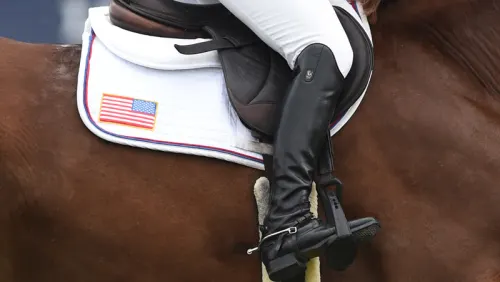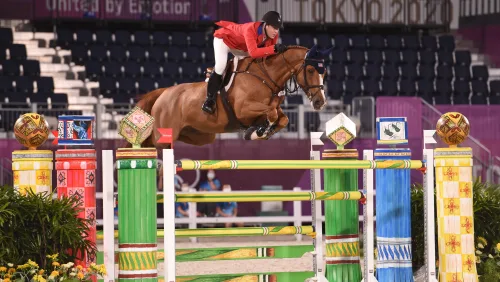The details of that mild July day in Vermont two years ago remain crystal clear in Alissa Kinsey’s memory. While waiting for the buzzer in the 1.15-meter adult amateur jumper classic at the Manchester Summer Festival, Kinsey reviewed her jump-off strategy with Capella 37. She entered the ring, and her round flowed perfectly according to plan—until the backside of the second-to-last fence.
“She took a funny step, then waffled a bit,” says Kinsey. “I thought she had just stung herself.”
She turned back to her last jump. Capella locked onto the fence, cleared it and pulled up smoothly. But Kinsey couldn’t shake the feeling something was off.
While they waited for the results, she found a quiet spot for the 18-hand Danish Warmblood (Cajus—Wirginia, World Record) to catch her breath. When Kinsey started to lead the mare to her trailer, Capella took one step, bobbed her head and refused to move.
“I thought maybe it was just a pulled muscle,” says Kinsey, 40. “I took her boots off, and there was nothing obvious. So I waited a moment, then led her to the trailer. She seemed to walk it off.”
But by the time Kinsey had untacked, Capella was holding up her left front leg. Kinsey called the show veterinarian, who couldn’t find anything obvious. The vet medicated the mare so she would be comfortable for the three-hour ride home to East Hampstead, New Hampshire, and Kinsey planned to do further diagnostics with her local veterinarian if necessary.
“I really hoped that I would get home, and she would be happy and comfortable,” says Kinsey. “And she did get off the trailer and walked to her stall. I have owned so many horses, and most every [injury] shows some initial swelling, a reaction to palpation, something. I thought maybe she was being a little dramatic, and this was something that rest would take care of.”
That night, Kinsey replayed her ride in her mind. She went back and forth between thinking Capella would be fine and worrying that something was really wrong.
After a few days off, Capella seemed to be improving. She moved freely in her stall and was bearing weight on the left fore. Encouraged, Kinsey took the mare to Essex Equine in Bolton, Massachusetts, where her veterinarian, Brett Gaby, DVM, could do a complete work-up. Capella still jogged lame, but X-rays and blocks were inconclusive. Then an ultrasound revealed bad news—there was damage to the proximal suspensory ligament, and a tiny piece of the cannon bone had been pulled away by surrounding soft tissue.
“My vet diagnosed it as an avulsion fracture,” says Kinsey. “He thought that with eight weeks of stall rest she would be OK.”
To be extra safe, Kinsey waited 10 weeks before Capella’s recheck.
“I thought we were going to get a green light to go back to work,” says Kinsey.
But when they jogged Capella, she was just as lame as she had been 2 ½ months earlier. Gaby repeated the X-rays and ultrasound. This time, in several images he saw a possible stress fracture with associated demineralization extending up through the cortical bone. In addition, the original avulsion fracture still hadn’t healed.
“My vet just looked at me and asked if she was insured,” says Kinsey.
She wasn’t. And without the funds to do an MRI or CT scan, there was no way to confirm the diagnosis. Gaby chose his words carefully.
ADVERTISEMENT
“You never want to give them bad news,” says Gaby. “In general, a front end suspensory is the most healable injury that won’t necessary limit a horse’s future career. But a stress fracture associated with demineralization can lead to a potential larger fracture down the line. It is like a chink in the armor. Without being able to positively confirm the fracture, I couldn’t be 100% sure what [Capella’s] potential would be to return to her previous level of work.”
Kinsey was devastated. With no budget for further diagnostics or sophisticated therapies, long-term rest was her only option. Considering Capella’s high-octane disposition and size, Kinsey worried about a catastrophic breakdown and pondered the mare’s future.

Alissa Kinsey refused to give up on Capella 37, and her patience paid off when the mare made her return to the show ring. Jon McCarthy Photography Photo
“But I didn’t want to give up on the horse,” says Kinsey. “I thought to myself, ‘I have to try.’ It is always the horse first, and I told myself that if at any time this goes south because of the injury, if her health is changing in any negative way, I wouldn’t allow her to suffer.”
At a minimum there’d be six months of stall rest, and one of Kinsey’s first steps was to put Capella on an extreme diet so her large frame carried the least amount of weight possible.
“I did anything I could to prevent her from hurting herself more,” says Kinsey. “We kept a hay net hanging on one side of the stall to try to minimize how much she moved around. I did anything I could to entertain her. After a few months she seemed to accept it and calmed down. I think that is when the healing began.”
In addition, Kinsey began using a human tool called a bone growth stimulator. These units emit electrical impulses or ultrasonic waves and are believed by some to increase healing of fractures. “I used it several times a day, because it made me feel like I was doing something,” says Kinsey. “I am not made of money, and I didn’t want to go crazy with treatments. Besides, there wasn’t much more you could do besides wrap her.”
When it came time for Kinsey to head to her winter base in Wellington, Florida, Capella had already been on stall rest for several months, and she got the OK to make the trip. The mild weather agreed with Capella, further improving her attitude. One day, Kinsey decided to take Capella for a walk; the mare was wild—but she was also sound.
“We had a long, protected barn aisle where we were stabled,” says Kinsey. “So I just started walking her there, up and down the aisle.”
After several weeks of handwalking, Kinsey asked Capella to take a few steps of trot. She could hardly breathe as she watched the mare trot out evenly. She immediately called Gaby.
“He suggested flexing and jogging her, and if she was still sound, to start rehabbing her under saddle,” says Kinsey. “As long as she stayed sound, I had the green light to start bringing her back.”
After nine months of rest, Kinsey got on Capella for the first time in a round pen, and for weeks she walked and walked. Eventually, she added in some short trots. “By the end of the winter circuit, I was flatting her about 10 minutes a day,” says Kinsey. “She was still barefoot, and I kept her on soft footing or grass. I just thought to myself, at least she is sound and happy.”
Back north the following spring, Kinsey continued Capella’s rehab and pondered her next move. The mare hadn’t put a foot wrong under saddle, and each day she seemed stronger—not yet back to her old self, but well on the way. Kinsey began to wonder if, perhaps, a riding career might be possible for her talented partner. Once again, she called Gaby for advice.
“His response was, ‘If she is sound on the flat, then she is telling you she is sound,’ ” says Kinsey. “He said it would be OK to start jumping some small fences.”
Slowly, Kinsey started to add jumping back into Capella’s work.
“She was beyond excited,” says Kinsey. “It was more rodeo than jumping. I only needed to jump one actual jump, because she basically jumped a whole course with her leaping. She was just so happy to be back doing what she wanted to do.”
ADVERTISEMENT
Kinsey continued to focus on fitness and conditioning, taking her time to make sure Capella’s work matched her physical condition. In July, she took her to a small local show.
“I never in my wildest dreams thought she would recover to show-worthy health,” says Kinsey. “She just marched around, happy and healthy. We both had big smiles on our faces.”
The next day, Kinsey held her breath again as she jogged Capella.
“She came out 100 percent,” says Kinsey.
The Northampton Horse Show (Massachusetts) offered a 1.20-meter welcome class early in the week in August, and after some hesitation, Kinsey sent in her entry.
“I decided that she was fit enough,” says Kinsey. “I told myself, ‘It is what it is. Take a chance.’ ”
Kinsey jumped only three fences in the warm-up because she didn’t like the footing in the practice ring. But Capella felt ready. And once in the arena, it was like nothing had changed. But no one was more surprised to see her number at the top of the leaderboard that day than Kinsey.
“It was just unreal,” says Kinsey. “It was the first class we really made the effort for since her injury. From nearly going in the ground to going to the ring—I couldn’t have been more ecstatic.”
In late September, Capella returned to the show ring, this time under the lights at the Deerfield Fair in New Hampshire. Though not a rated competition, its jumper classic offers $5,000 in prize money and draws some of the top jumper talent in the area. Kinsey brought Capella with modest expectations.
“But the horse only has one pace,” says Kinsey. “We won the class by 2 seconds.”
More important than the win for Kinsey was the affirmation that she’d made the right choice for her horse.
“It showed that she was back,” says Kinsey.
Now 16, Capella has little to prove. Kinsey reserves the mare for special occasions. “I would love to get her back up into the bigger classes, but in my mind [the injury] is always there,” says Kinsey. “I want to keep her healthy. Nothing is worth any unnecessary risk.
“She doesn’t need to go to the horse shows every week,” continues Kinsey. “I am just enjoying my mare.”
Do you know a horse or rider who returned to the competition ring after what should have been a life-threatening or career-ending injury or illness? Email Kimberly at kloushin@coth.com with their story.
















